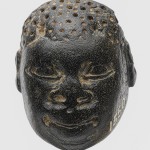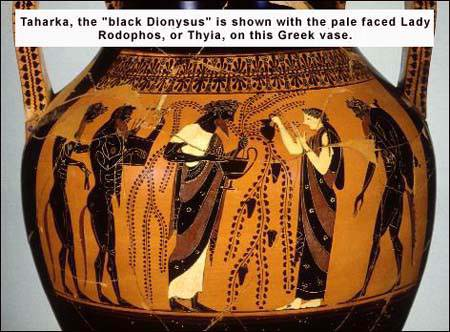
By Jide Uwechia with cited sources
The Benin Haplogroup or Haplogroup 19 Common in Africans, southern Greeks, Sicilians, and Albanians
There are at least four distinct African, (known as Senegal, Congo, Benin, Bantu Hbs Haplogroups) and one Asian chromosomal backgrounds (haplotypes) on which the sickle cell mutation has arisen.
The Benin haplotype (which originates from Nigeria, West Africa) accounts for HbS associated chromosomes in Sicily Northern Greece, Southern Turkey, and South West Saudi Arabia, suggesting that these genes had their origin in West Africa. The Asian haplotype is rarely encountered outside its geographic origin because there have been few large population movements and Indian emigrants have been predominantly from non HbS containing populations. Per:Graham R. Serjeant, MD, FRCP, The Geography Of Sickle Cell Disease:Opportunities For Understanding Its DiversityRSITY: http://www.kfshrc.edu.sa/annals/143/rev9239.html
Nigeria, west Africa appears the most logical origin of the sickle mutation in Greece evidence from beta S globin gene cluster polymorphisms (1991). It has been conclusively demonstrated that HbS in Greece is mostly haplotype #19 (the one that originated in Benin, Nigeria West Africa). See, Boussiou M, Loukopoulos D, Christakis J, Fessas P.; The origin of the sickle mutation in Greece; evidence from beta S globin gene cluster polymorphisms. Unit for Prenatal Diagnosis, Laikon Hospital, Athens, Greece.
Additionally, previous data suggest that the S/Bantu haplotype (from Southern Africa) is heterogeneous at the molecular level. Recent studies also report a similar heterogenity for the Benin Haplogroup. A study demonstrated the presence of the A -499 TA variation in sickle cell anemia chromosomes of Sicilian and North African origin bearing the S/Benin haplotype (from Nigeria). Being absent from North American S/Benin chromosomes, which were studied previously, this variation is indicative for the molecular heterogeneity of the S/Benin haplotype. Am. J. Hematol. 80:79-80, 2005.
A study was done in Albania (which borders Greece) relating to sickle cell anemia, sickle cell beta-thalassemia, and thalassemia major in Albania. The focus of the study was the characterization of sickle cell mutations. As one would expect, it was shown that the HbS mutation in the Albanian sample is the Benin (Nigeria)-originating haplotype #19. See, Boletini E, Svobodova M, Divoky V, Baysal E, Dimovski AJ, Liang R, Adekile AD, Huisman TH.; Sickle cell anemia, sickle cell beta-thalassemia, and thalassemia major in Albania: characterization of mutations. : Hum Genet. 1994 Feb;93(2):182-7.
According to a study done in 1973, before the availability of the advanced data cited above, “the occurrence of the sickle-cell trait in southern Europe …. is believed to reflect gene flow from the Middle East.” See A. P. GELPI, M.D, “Migrant Populations and the Diffusion of the Sickle-Cell Gene” August 1, 1973 vol. 79 no. 2 258-264 http://www.annals.org/content/79/2/258.abstract.
The problem with this 1973 study is that it assumes that the sickle cell genes came with the Arabs. Alas, updated research work has proven beyond doubt that the sickle cell genes proven to exist in southern Europe are exclusively Sickle cell gene Haplotype 19 or the Benin Sickle cell gene from Nigeria.
Y Haplogroup E-M78 and YAP In Black Africans and Greeks
Y Haplogroup E-M78 a derivative of E3B is a signature African gene as confirmed in research studies over the last few years. The high frequency of this haplogroup in Greece suggests the presence of a substantive African population in that region during prehistoric and historical time periods.
A recent paper has detected clades of haplogroups J and E3b that were likely not part of pre-historic migrations into Europe, but rather spread by later historical movements. Greeks .. [then there is] the marker J-M267, which may reflect more recent Middle Eastern admixture.
(Semino et al., Am J Hum Genet, 2004) E3b originates from East Africa while there is a high frequency of J-M267 in the East Coast of Africa as well as the Red sea coast of Arabia.
A recent sampling of the Greek population comprised 36 Peloponnesian samples, 5 of which were J-M172(xM12) and 17 of which were E-M78 (R.K., unpublished data).
In spite of the small Peloponnesian sample size, the high E-M78 frequency (47%) observed here is consistent with that (44%) independently found in the same region (Di Giacomo et al. 2003) for the YAP chromosomes harboring microsatellite haplotypes A. (Novelletto, personal communication) (Cruciani et al. 2004).
The study by by Di Giacomo et al. found the following African haplogroups in Greeks: Haplogroup A which is highly specific to West Africa, R1a, DE, and J2*(xDYS413= 18)J*(xJ2). R1* which probably gave rise to R1a is found in Northern Cameroon. DE is found principally among Nigerians and it is suspected that it originated from Nigeria. J is very prominent in East, and North Africa.
High-resolution Y-chromosome haplotyping and particular microsatellite associations reveal … an East Africa homeland for E-M78.Origin. See Ornella Semino, Chiara Magri, et al “Diffusion, and Differentiation of Y-Chromosome Haplogroups E and J: Inferences on the Neolithization of Europe and Later Migratory Events in the Mediterranean Area” http://www.pubmedcentral.nih.gov/articlerender.fcgi?tool=pubmed&pubmedid=15069642
HLA Genetic Relationship Between Ancient Greeks and Black Africans
HLA genes are reliable markers of past population movement and are still used in laboratories today to establish genetic inter-relationship amongst seemingly diverse peoples.
HLA genes in Macedonians and the sub-Saharan origin of the Greeks (2001) was a study conducted by Dr. Arniaz and other scholars in a top flying Spanish University. This study uses HLA genes to establish the African dimension of the roots of ancient Greece.
According to the Arniaz study, …Greeks are found to have a substantial relatedness to sub-Saharan (Ethiopian) people, which separate them from other Mediterranean groups. Both Greeks and Ethiopians share quasi-specific DRB1 alleles, such as *0305, *0307, *0411, *0413, *0416, *0417, *0420, *1110, *1112, *1304 and *1310. Genetic distances are closer between Greeks and Ethiopian/sub-Saharan groups than to any other Mediterranean group and finally Greeks cluster with Ethiopians/sub-Saharans in both neighbour joining dendrograms and correspondence analyses. The time period when these relationships might have occurred was ancient but uncertain and might be related to the displacement of Egyptian-Ethiopian people living in pharaonic Egypt. See Arnaiz-Villena A, et.al: HLA genes in Macedonians and the sub-Saharan origin of the Greeks. Tissue Antigens. 2001 Feb; 57(2): 118-27
There is a fraudulent claim (by those with idealogical investments in the topic) on the Internet that this study has been “retracted” or “refuted.” The study is perfectly valid. Sub-Saharan-specific and quasi-sub-Saharan-specific alleles were definitely detected in the Greek population at the DRB1 locus, and this is not open to question.
It would be helpful here to discuss the study that was retracted, and the reason why. It is the work titled: “The origin of Palestinians and their genetic relatedness with other Mediterranean populations” (which contained some cross-referenced Greek data in a neighbor-joining dendogram and a correspondence analysis) that was retracted. And it was retracted solely and strictly for political reasons, as this Observer article makes crystal clear:
http://www.guardian.co.uk/Archive/Article/0,4273,4307083,00.html
(Keep in mind we are dealing with the study on the relatedness of Jews and Palestinians at the moment, which was retracted, and not the one on the Greek-Black African relatedness, which was not retracted and remains valid. The two must not be confused.)
Appreciations to: http://onedroprule.org/about1071.html
Epilogue:
“Hb S is common in some areas of the Mediterranean basin, including regions of Italy, Greece, Albania and Turkey (Boletini et al., 1994) (Schiliro et al., 1990). Haplotype analysis shows that the Hb S in these areas originated in Africa. The genes probably moved along ancient trading routes between wealthy kingdoms in western Africa and the trade centers in the Mediterranean basin.” (Harvard University, http://sickle.bwh.harvard.edu/scdmanage.html)
“Usually, people with sickle cell disease outside Africa (e.g., blacks in the United States) or India have mixed haplotypes for their sickle cell genes.” (Harvard University, http://sickle.bwh.harvard.edu/scdmanage.html)
“Templeton gives a modern-day analogy: the presence of a gene for sickle cell anemia in Caucasians in Portugal. The gene traces back to a mutation that occurred in Africa and spread through interbreeding between Africans and Europeans. “The Africans didn’t come up, reconquer the Iberian peninsula, kill off all the Europeans, and that’s why there are sickle cell alleles in Portugal today,” he says. The presence of the sickle cell gene in Portugal “means that Portuguese and Africans have met and they’ve interbred, just like humans tend to do.” – “Out of Africa” – Ruth Flanagan, Contributing Editor, Earth Magazine, http://www2.mc.maricopa.edu/anthro/l…ofAfrica5.html




More pseudo fairy tales by pseudo ‘scholars’. Yup agree with you on one thing, this is why the youth of today isn’t interested in history and science anymore, they’d rather believe in fictional things like the “Book of the Begininnings”, “Metamoporphsis” and “The Great Initiates”. Pitiful.
(1) Regarding Y-DNA R1b1* from Cameroon:
Dave how does Asian Y-DNA R differ from African Y-DNA R1b1*??
We need an answer today!
(2) Regarding Haplogroup E3B, Peter Underhill states:
Ann. Hum. Genet. (2001), 65, 43±62
The phylogeography of Y chromosome binary haplotypes and the origins of modern human populations
“As mentioned before in relation to African NRY history, a Mesolithic population carrying Group III lineages with the M35}M215 mutation (Jahdey’s comments: E3B) expanded northwards from sub-Saharan to north Africa and the Levant.â€
Thanks to OneWorl for the comments.
Jahdey
Haplogroup R and variants
http://en.wikipedia.org/wiki/Haplogroup_R_%28Y-DNA%29
….Haplogroup R1b1* (P25-derived) is found at high frequency among the native populations of northern Cameroon in west-central Africa….Some Y-chromosomes that appear to be closely related to the northern Cameroonian R1b1* are found at a substantial frequency among the modern population of Egypt. Many modern populations of northern Cameroon speak Chadic languages, which are classified as an ancient branch of the Afro-Asiatic superfamily of languages; the now extinct language of the Ancient Egyptians also belonged to the same superfamily.
Haplogroup R1b originated prior to or during the last glaciation, when it was concentrated in refugia in southern Europe and the Aegean. It is the most common haplogroup in Western Europe, but has been found at low frequency as far away as Iran and Korea. It is also found in North Africa where its frequency surpasses 10% in some parts of Algeria. In south-eastern England the frequency of R1b is about 70%; in parts of the rest of north and western England, Spain, Portugal, Wales and Ireland, it is as high as 90%; and in parts of north-western Ireland it reaches 98%. The R1b clade appears to have a much higher degree of internal diversity than R1a, which suggests that the M343 mutation that derives R1b from R1* may have occurred considerably earlier than the SRY1532 mutation that defines R1a.
You neglected to mention the most important facts as usual in your Afrocentric views: that R1 place of origin is in Asia; it is very common throughout Europe and western Eurasia and its found in Cameroon because of to BACK migration and the one found in Cameroon is ONE isolated clade (or clades) of Y chromosomes:
“It is believed to have occurred somewhere in Northwest Asia between 30,000 and 35,000 years ago. The majority of members of haplogroup R belong to the Haplogroup R1, defined by marker M173. R1 is very common throughout Europe and western Eurasia Its main subgroups are R1a (SRY1532) and R1b (M343).
One isolated clade (or clades) of Y chromosomes that appear to belong to Haplogroup R1b1* (P25-derived) is found at high frequency among the native populations of northern Cameroon in west-central Africa, which is believed to reflect a prehistoric BACK-migration of an ancient proto-Eurasian population into Africa;”
http://en.wikipedia.org/wiki/Haplogroup_R_%28Y-DNA%29
Dave
The only problem with you is that you read without discernment. You lack critical skills.
How can Asia be the origin of a gene which is found in Africa when we all know that Africa has been demonstrated to be the birth place of real Homo Sapiens?
When did this so-called back-migration take place?
What is the difference between African R1b1 and Asian R?
Have you ever cared to take a look at the pictures of the original Austronesians?
Go look at the pictures of the Andamanese, the earliest Asians. Check out the Australian Aborigines, go take a peek at the Fijians, the New Guineans, the negritos of Philipines and Malaysia.
When you look at those pix, come back and tell me your discovery. Just google the terms and click on the image tab, so the scales in your eyes will fall off.
Jahdey
And as usual you keep forgetting to mention key facts. Such as Dr. Underhill states the E3B alpha cluster found in Europeans cannot be used as an index of black African ancestry. BTW, you do realize that “African NRY” history talks about non-recombinant Y lineages, right? I.e. Out of Africa theory = non-recombinant Y lineages = Genetic recombination, the process by which a strand of genetic material is broken and then joined to a different DNA molecule, it is one of the ways a gene mutated = what scientists have been proven about genetic all along = that grouping all together as ‘same’ while ignoring expansion dates, the geographic positioning and distribution of each clusters that mutanted is misleading and goes against what geneticists say.
The problem with you, Jahdey, is you want to choose and pick what you want people to read, doesn’t work that way. You provided that article regarding Haplogroup R and when in that article that YOU provided specific states Northwest Asia as the place of origin for R and speaks about “a prehistoric back-migration of an ancient proto-Eurasian population into Africa;” you try to back track. Sorry can’t have it both ways.
http://en.wikipedia.org/wiki/Haplogroup_R_%28Y-DNA%29#R1